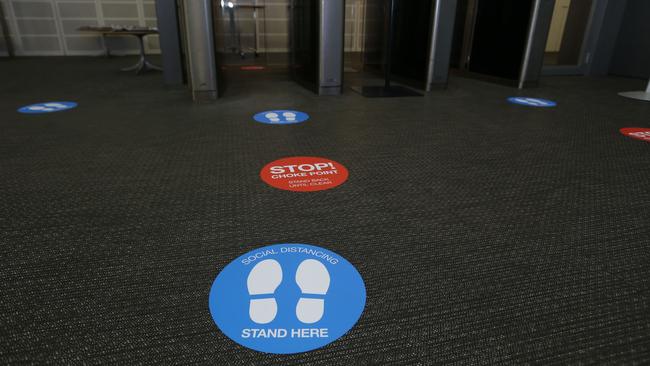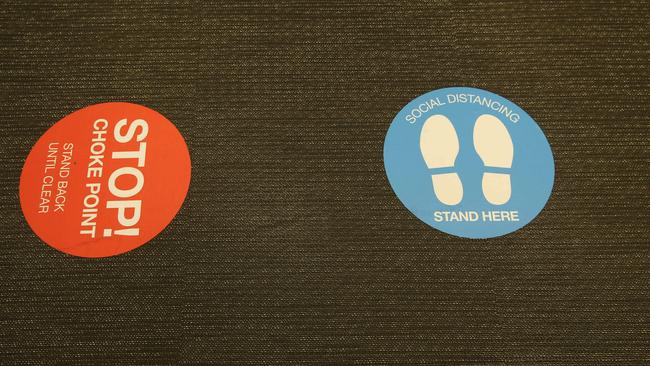Back to work, but it’s different this time
The lights are back on in empty office towers across Australia as the first wave of workers prepare to return to work on Monday.

The lights are back on in empty office towers across Australia as the first wave of workers prepare to return to work on Monday.
Lines are being drawn, circles added and spray screens installed as experts point the way for workplaces to reshape themselves for work during a pandemic.
About 20 per cent of workers are already back at work, but slim numbers in the CBD in Sydney on Friday suggest many more are missing.
Analysts are tipping that up to half of the nation’s CBD workforce could be back at the office by mid to late June, joining a legion of tradies who never left building sites across cities.
Banking major ANZ has said it will look to bring back about 40 per cent of staff across its buildings, with teams coming in on a rotational basis.
Deputy chief executive Alexis George said staff would be required to adhere to strict conditions including thermal scanning on entry, limiting the number of people in lifts, no movement of staff between floors, extra cleaning and closure of communal areas, including meal areas where staff congregate.
“We have been encouraging staff to hold meetings remotely, but eventually face-to-face meetings will be allowed, in line with strict social distancing and personal hygiene guidelines,” she told The Weekend Australian.
Other companies are rostering “A” teams and “B” teams to split the return to the office and keep numbers down.

Workplace design advisory company Hayball has been working with big banks and companies to assist them in preparing for returning waves of workers.
Hayball principal Donna Wheatley said many of the changes they were suggesting would shape the workplace of the future.
“In the future health and wellbeing will be a core element and productivity will be at the centre of those arrangements. It’s going to impact not just fit-outs but the design of buildings as well,” she said.
Dr Wheatley said in some buildings, circles denoting social distance were being marked on the ground, and sneeze guards added to allow workers to face each other.
In many common areas seating will be removed and workers will be discouraged from venturing outside for lunches, both to minimise the risk of spreading the virus and to reduce the burden on lifts and stairs — the frontline of social distancing measures in office towers.
Dr Wheatley said businesses would also look to add acoustic screens around what seating remained in common areas to facilitate video conferencing between those not in the workplace.
“There’s a balance between making an environment safe and healthy for staff and not spending too much money,” she tells The Weekend Australian.
“I don’t think it’s going to be much different for the amount of space organisations use; it’s just going to be used in a really different way.”
PwC chief strategy, risk and reputation officer Sean Gregory said his firm would be introducing “a mix of remote working, staggered shifts and physical distancing in our offices” as it brought back its first waves.

“We are recommending that larger meetings continue to be held virtually and necessary face-to-face meetings are kept to a maximum two hours,” he said.
Victorian Premier Daniel Andrews on Friday warned his government would not tolerate businesses sending workers back to the office en masse.
“If an office that had, currently, say 80 per cent of their staff working from home decided ‘ah well, we will just ignore the Chief Health Officer and we will have everybody come back Monday’, then they would be in breach of public health orders,” Mr Andrews said.
He said there were “potentially fines”, enforceable by spot checks, for businesses which brought too many staff back without proper social distancing provisions.
Hayball’s Dr Wheatley said many businesses’ plans to bring people back to the office depended on a considerable number of staff continuing to work from home.
“There’s a lot in the media saying everyone will have workstations but it’s not happening because they want to rotate staff and when they’re in the workplace spread them out,” she said.
“All the clients we’re working with that are doing desk sharing are still doing that; no one is assigning workstations.”
But it’s in the long run that many of the changes made in coming weeks will make their mark, with a redrawing of floorplans and a shift in expectations about work.
“A lot of companies want a prime core between 10-3 where you can do your core activity in that,” Dr Wheatley said.
“That works better for a lot of other people who have a lot of other obligations like childcare.”
University of Sydney professor of information technology and organisation Kai Riemer said a return to the office would be good for many who’ve spent the better part of 10 weeks working from home.
“The workplace can’t be fully functional without interpersonal communication. You need those incidental conversations that happen at the water cooler, or when you’re out to get a coffee,” he said.




To join the conversation, please log in. Don't have an account? Register
Join the conversation, you are commenting as Logout